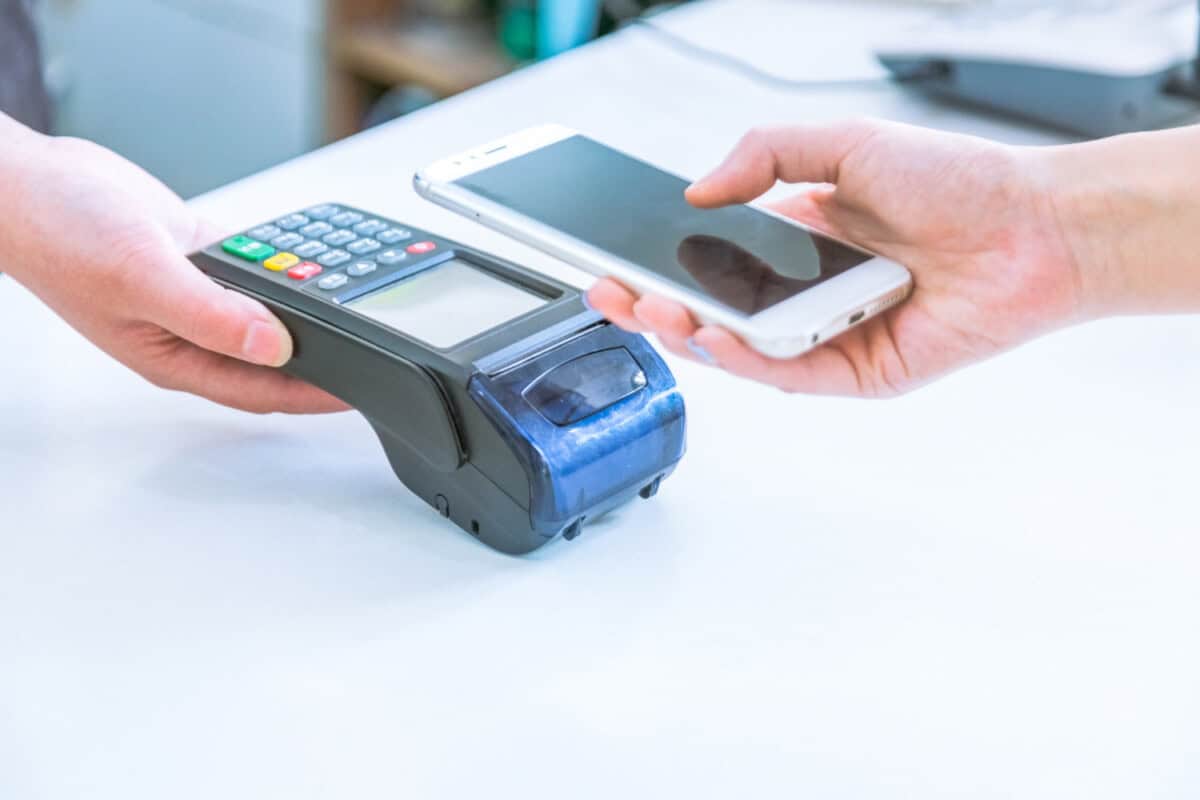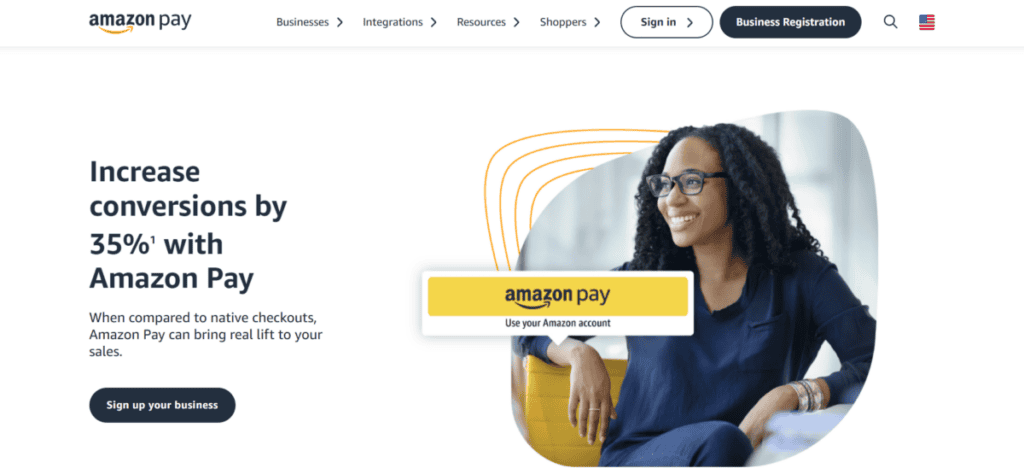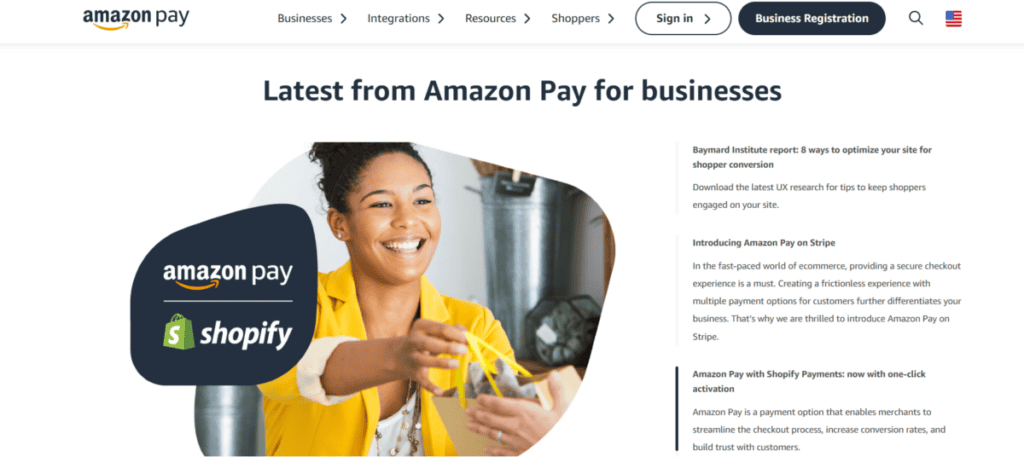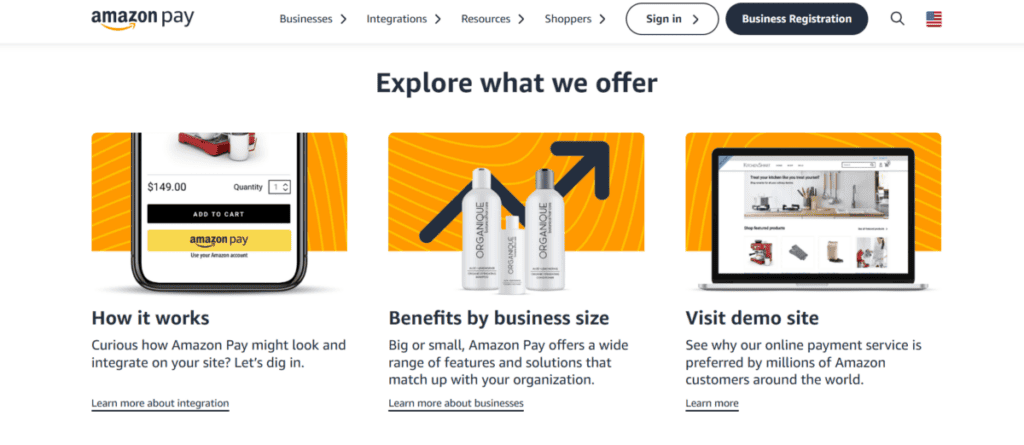
Amazon Pay Review
- 01st Apr, 2025
- | By Linda Mae
- | Reviews
Launched in 2007, Amazon Pay is a digital payment service designed to make it easier for customers to pay for goods and services online. Amazon Pay, which is based on one of the most reliable e-commerce platforms in the world, lets customers use the payment methods that are already linked to their Amazon accounts to complete transactions. The main advantage for both customers and retailers is convenience—customers don’t have to repeatedly enter their billing and shipping information or create new accounts. Lets read more about Amazon Pay Review.
Over the years, Amazon Pay has evolved into more than just a checkout option. It now offers features like voice-enabled payments through Alexa and integrations with ecommerce platforms, allowing merchants to deliver a seamless and familiar payment experience. By leveraging Amazon’s vast infrastructure, the service ensures secure and fast transactions, which is particularly attractive to online retailers looking for frictionless checkout solutions.
Amazon Pay is not without competitors, though. Each of the industry’s leading digital wallets, including PayPal, Apple Pay, and Google Pay, has advantages of its own. The vast user base that already trusts Amazon with their financial information sets Amazon Pay apart and greatly increases seller conversion rates.
How Amazon Pay Works | Amazon Pay Review
At its core, Amazon Pay functions as a payment gateway, enabling customers to pay on third-party websites using their Amazon credentials. It simplifies the checkout process by allowing users to log in with their Amazon account and complete a purchase without entering additional details. This reduces friction, improves the shopping experience, and increases the likelihood of purchase completion.
On choosing Amazon Pay during the checkout process, the website takes users to a secure page hosted by Amazon. They can select from the available payment options there, validate their order, and then go back to the merchant website. Similar to other digital wallets, this simplified method sets itself apart by leveraging Amazon’s well-established infrastructure and user base.
For merchants, Amazon Pay works through a simple integration, either via direct API or through popular ecommerce platforms like Shopify, WooCommerce, and Magento. It supports both one-time and recurring billing, making it suitable for a variety of industries, including retail, digital services, and subscriptions.
Amazon Pay also extends into voice commerce, allowing customers to use Alexa-enabled devices to make purchases and manage subscriptions. This represents a unique edge in the digital payments space, especially as voice shopping continues to grow.
The entire transaction is processed securely through Amazon’s backend, ensuring fast and reliable performance. From a technical standpoint, Amazon Pay is relatively easy to integrate and manage, with a merchant dashboard that provides transaction tracking, refunds, and performance reporting.
Key Features and Services
Amazon Pay offers a suite of features aimed at simplifying payments while enhancing both merchant and customer experiences. Its most notable strength is the one-click checkout powered by existing Amazon account information. Customers don’t have to re-enter shipping or billing details, which drastically reduces checkout time and increases conversion rates.
Another standout feature is voice-enabled payments via Alexa, allowing users to complete transactions using voice commands. While still emerging, this tech-forward option highlights Amazon’s commitment to innovation in commerce.
Because subscriptions and recurring payments are supported, managing billing cycles is made simpler for companies that provide SaaS, memberships, or monthly deliveries. For these applications, Amazon Pay offers customers convenience and steady revenue streams.
Mobile responsiveness is another strong area — Amazon Pay works seamlessly on mobile sites and apps, adapting well to various screen sizes and ensuring a consistent experience.
Customer trust plays a significant role in Amazon Pay’s appeal. Because shoppers recognize the Amazon brand, they often feel more comfortable completing purchases, even on unfamiliar websites.
Other features include:
Multi-currency support
Buyer protection
A robust developer toolkit
Support for refunds and partial captures
While the feature set is impressive, some limitations exist. For instance, it lacks built-in invoicing tools, and certain advanced features (like custom checkout experiences) require developer involvement.
Overall, Amazon Pay offers a well-rounded package, especially for businesses seeking a reliable, brand-trusted solution that enhances customer convenience and engagement.
Merchant Experience and Onboarding
Getting started with Amazon Pay is generally straightforward for most businesses. The onboarding process involves signing up with business credentials, verifying identity, and integrating the payment gateway into your website. For merchants already familiar with Amazon Seller Central, the process feels familiar and easy to navigate.
Amazon provides SDKs and API documentation for custom integrations, as well as prebuilt plugins for popular ecommerce platforms like Shopify, Magento, BigCommerce, and WooCommerce. This lowers the barrier for non-technical users while still offering flexibility for developers.
Clean and functional is the merchant dashboard. From there, companies can download reports, handle refunds, view transaction histories, and keep an eye on performance. It doesn’t have as many features or customization options as some stand-alone platforms, but it still covers the basics without unnecessary detail.
In terms of support during onboarding, Amazon offers documentation, FAQs, and a ticket-based support system. However, some users report slower response times compared to competitors with dedicated account managers or live chat support.
Another consideration is eligibility. Amazon Pay is not available to all types of businesses — high-risk industries or those with unclear product categories may face account restrictions or rejections during the application phase.
Overall, merchants who seek a smooth, reliable payment setup with minimal friction will find Amazon Pay to be a solid choice. It works best for businesses that value trust, ease of integration, and compatibility with customers who already shop on Amazon.
Customer Experience
Amazon Pay excels in providing a fast, intuitive, and secure payment experience for customers. Shoppers benefit from the ability to use their existing Amazon credentials, including saved addresses and payment methods, without creating a new account on the merchant’s site.
The number of steps required to finish a transaction is decreased by the one-click checkout process. On mobile devices, where long forms frequently result in abandoned carts, this is especially helpful. Additionally, customers receive email notifications and real-time payment confirmations, which increase transparency and security.
Another strong aspect is brand familiarity. Consumers already trust Amazon, and seeing the Amazon Pay option during checkout can instill a sense of reliability — especially on smaller or lesser-known websites. This trust often translates into higher conversion rates for merchants.
Voice-enabled payments via Alexa are also part of the experience for Amazon Pay users, though adoption is still limited. The functionality is smooth for users who are already within the Amazon ecosystem and adds a layer of futuristic convenience for repeat purchases and subscriptions.
On the downside, users who do not have an Amazon account are required to sign up for one, which could introduce friction. Additionally, Amazon Pay doesn’t support all local payment methods, which may be a limitation in global markets.
Fees and Pricing Structure
Amazon Pay follows a transparent and competitive pricing model, though it’s not the cheapest in the market. For U.S.-based merchants, the standard transaction fee is 2.9% + $0.30 per transaction for domestic payments. International transactions come with a slightly higher fee of 3.9% + $0.30, which is comparable to PayPal and Stripe.
There are no setup fees, monthly fees, or cancellation charges, which is a plus for small businesses and startups that want to avoid long-term commitments. You pay only when you process a transaction.
Although Amazon accepts refunds, the fixed amount ($0.30) of the transaction fee is not reimbursed. Although this is a standard procedure in the industry, merchants should be mindful of it when handling large amounts of refunds.
Chargeback fees apply, typically around $20 per chargeback, which is again in line with industry standards. However, Amazon offers some seller protections in cases of fraud and unauthorized payments.
From a pricing standpoint, Amazon Pay offers value for money, especially given the brand recognition and trust it brings. However, larger businesses with higher volumes might find more favorable rates through custom-negotiated contracts with competitors.
The fees are predictable and easy to understand, which makes financial planning simpler. Still, businesses should compare these rates to other processors based on their average order size, transaction volume, and international sales profile.
Supported Countries and Currencies
Amazon Pay is available in several major markets, but its global reach is still somewhat limited compared to payment giants like PayPal or Stripe. As of now, Amazon Pay is officially supported in countries such as the United States, United Kingdom, Germany, France, Italy, Spain, Japan, and India.
The platform supports multiple currencies depending on the country of operation. However, cross-border commerce may come with limitations, such as additional fees and restricted transaction types. For example, a U.S.-based merchant can accept international payments, but both the buyer and seller must be located in supported countries.
Businesses can accept payments in local currencies thanks to multi-currency support, which enhances customer satisfaction and lowers cart abandonment. However, there is no real-time currency conversion feature, and Amazon’s exchange rate might not always be the best.
It’s important for merchants to review Amazon Pay’s eligibility and availability policies based on their country of incorporation and the locations of their target customers. Also, not all business types are supported globally — high-risk categories or digital goods may face extra scrutiny or limitations.
Security and Fraud Protection
Security is one of Amazon Pay’s strongest assets, benefiting from Amazon’s reputation and robust infrastructure. The platform is PCI DSS compliant, meaning it meets industry standards for secure handling of payment information. Merchants don’t need to worry about managing sensitive data directly, as Amazon handles the encryption and storage of all payment details.
Transactions are secured using SSL encryption and other layered security protocols. Users must authenticate using their Amazon login credentials, which often includes 2FA, adding an extra layer of protection for customers.
Amazon Pay includes built-in fraud detection systems that monitor transactions for suspicious behavior. These systems help flag or block unauthorized payments before they’re completed, reducing the risk of chargebacks and fraud-related losses for merchants.
Amazon provides sellers with A-to-Z Guarantee protection for eligible transactions, helps in dispute resolution and offers some financial security in the event of fraud. However, if customers abuse the system, this can occasionally work against sellers, leading to disputes being settled in the buyers’ favor.
One notable limitation is the lack of detailed fraud management tools for merchants. Unlike platforms such as Stripe Radar or PayPal’s Seller Protection dashboard, Amazon Pay keeps much of its fraud decision-making internal, offering little customization or transparency.
Integration Options
Amazon Pay offers flexible integration options to accommodate a wide range of businesses — from tech-savvy startups to non-technical entrepreneurs. The service provides API-based integration, which allows developers to create custom checkout experiences and tailor the payment flow to specific business needs.
For merchants without technical expertise, Amazon Pay has ready-to-use plugins for popular ecommerce platforms like:
Shopify
WooCommerce
Magento
BigCommerce
PrestaShop
These plugins make it easy to activate Amazon Pay without writing a single line of code. Once installed, the payment option appears alongside other checkout methods, and transactions are processed through Amazon’s backend.
Amazon also offers a sandbox environment for testing, as well as detailed developer documentation. The API supports advanced features like recurring billing, voice payment, and mobile-optimized checkout experiences.
The checkout user interface’s lack of customization is one area that needs work. Although useful, Amazon Pay’s branded experience occasionally clashes with the layout of a merchant’s current website. Additionally, more developer work might be needed for companies wishing to create multi-step forms or more intricate checkout processes.
Still, the integration process is relatively smooth for most users. Whether you want a plug-and-play solution or a fully custom implementation, Amazon Pay provides the flexibility needed to get started without a steep learning curve.
Performance and Reliability
Amazon Pay benefits from Amazon’s global infrastructure, which ensures high availability, fast processing speeds, and minimal downtime. Transactions are typically completed within seconds, and the payment system rarely experiences outages — a testament to Amazon’s reliable cloud architecture.
For merchants, this means fewer failed payments, less downtime during checkout, and an overall smoother experience for both buyer and seller. The latency is low, even during peak shopping periods, such as Black Friday or holiday seasons, when many other gateways may experience lags or crashes.
The Amazon Pay dashboard provides real-time updates, including transaction status and refund processing. Reports are generated quickly, and data exports are easy to access, making backend operations more efficient.
Real-time assistance during outages or technical problems is not common despite its dependability. In situations where time is of the essence, merchants are usually forced to rely on ticket-based support, which can be slow to respond. Some customers still feel that Amazon’s support is not as important as that of its rivals who provide live chat or phone-based assistance.
Additionally, while system uptime is impressive, there’s limited public transparency or status tracking available — something platforms like Stripe and PayPal now provide as standard.
Mobile and Voice Commerce Capabilities
Amazon Pay offers a strong mobile commerce experience and stands out in the emerging space of voice commerce. The platform is fully optimized for smartphones and tablets, ensuring quick page loads, responsive design, and compatibility across major mobile operating systems.
For developers, the Amazon Pay API supports in-app payments, making it easy to offer seamless mobile checkout within native applications. This improves the customer experience and reduces drop-off at the final stage of the transaction funnel.
The integration of Amazon Pay with Alexa, the company’s voice assistant, is what really sets it apart. An innovative feature for innovative brands is the ability for customers to place orders, verify subscriptions, and handle payments using voice commands. Even though voice commerce adoption is still in its early years, Amazon is unmistakably setting itself up for success.
Voice-enabled commerce also includes reordering capabilities. For example, customers can say, “Alexa, reorder dog food,” and the transaction completes using stored Amazon Pay details. This can be a game-changer for consumable products and repeat purchases.
However, voice commerce features are heavily tied to the Amazon ecosystem, and may not be relevant or accessible to merchants and consumers outside that circle. Also, privacy concerns around voice assistants remain a point of contention for some users.
Overall, Amazon Pay delivers a robust and evolving mobile and voice commerce experience, ideal for businesses wanting to stay at the forefront of innovation while ensuring a smooth mobile checkout.
Use Cases: Ideal Business Types
Amazon Pay is best suited for ecommerce businesses that prioritize customer trust and streamlined checkout. It’s particularly effective for companies that sell to consumers who are already familiar with and have an active Amazon account — a sizable demographic in regions like the U.S., UK, and Germany.
Retail stores, digital goods sellers, subscription services, and donation platforms are well-suited to the platform. Amazon Pay supports recurring billing and quick reordering, which is useful for memberships, media services, or any model that benefits from repeat purchases.
Amazon Pay is a fantastic choice for small and mid-sized businesses since it offers sophisticated features without expensive upfront fees or complicated contracts. Additionally, it is simple to manage and integrate, which is advantageous for teams with limited resources.
However, Amazon Pay is not ideal for high-risk businesses, companies selling prohibited items, or those based in unsupported regions. Certain business types — like gambling, adult services, or firearms — may be restricted or denied access.
Also, B2B merchants or those with complex invoicing needs might find the platform lacking in flexibility compared to specialized payment solutions.
Customer Support and Resources
Customer support is one area where Amazon Pay receives mixed reviews. While Amazon is known for its strong customer service in retail, its merchant support for Amazon Pay is more limited.
Support is offered primarily through a ticket-based system and email, with response times that can vary depending on the complexity of the issue. Some merchants report receiving answers within 24 hours, while others experience delays during peak periods.
There is no 24/7 live chat or phone support for most users, which is a drawback compared to competitors like PayPal or Stripe that offer real-time assistance. This lack of immediacy can be frustrating, especially when dealing with time-sensitive issues such as payment disputes or technical bugs.
On the plus side, Amazon Pay offers comprehensive integration guides, developer documentation, and a knowledge base that is well-structured and addresses the majority of frequently asked questions. There is also a vibrant developer community, and forums can be useful for troubleshooting.
Amazon occasionally provides dedicated support for large-volume sellers, but this is typically reserved for enterprise clients or partners with negotiated contracts.
Overall, Amazon Pay’s support is adequate for most routine issues, but not ideal for businesses that require constant, hands-on assistance. It’s best suited for merchants who are comfortable with self-service resources and can afford a bit of wait time for escalations.
Pros and Cons
Pros:
Trusted brand that increases consumer confidence
Seamless checkout using Amazon credentials
Easy integration with popular ecommerce platforms
Voice and mobile commerce capabilities
Strong fraud protection and PCI compliance
No monthly or setup fees
Cons:
Limited global availability
No real-time customer support
Lack of advanced fraud management controls for merchants
Requires Amazon account for customers
Not ideal for high-risk industries or B2B invoicing
Amazon Pay provides a strong combination of ease of use, convenience, and trust, particularly for e-commerce companies that interact with customers. But not all business models are a good fit for it. The limited global reach and absence of real-time support might be deal-breakers for some. Yet, Amazon Pay can help boost conversions and provide a seamless checkout process for companies that fit its ideal use case.
FAQs
1. Is Amazon Pay only available to Amazon sellers?
No, Amazon Pay can be used by any online merchant — not just those who sell on Amazon’s marketplace. You can integrate Amazon Pay into your own website and accept payments from any customer with an Amazon account.
2. Does Amazon Pay store customer data?
Amazon Pay uses the billing and shipping information already stored in a customer’s Amazon account. However, it doesn’t share full customer data with merchants, preserving user privacy while still enabling smooth transactions.
3. How long does it take to receive funds from Amazon Pay transactions?
Payouts are typically disbursed to a merchant’s bank account within 3–5 business days, depending on the bank and country. New accounts may experience slightly longer settlement times during initial verification.



